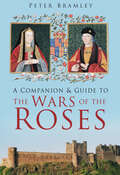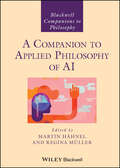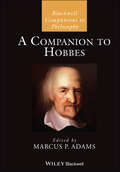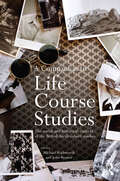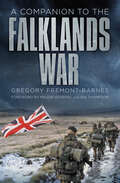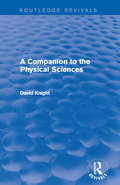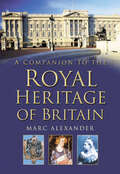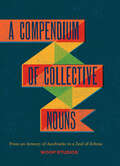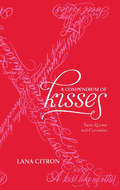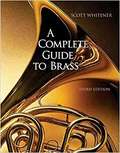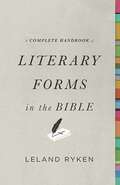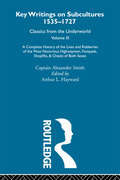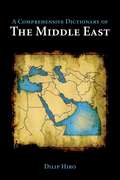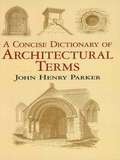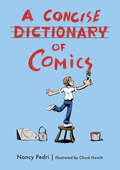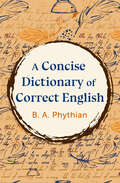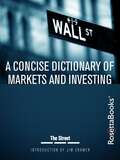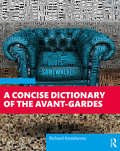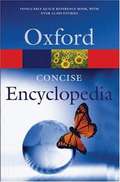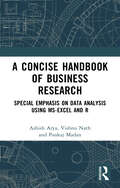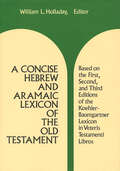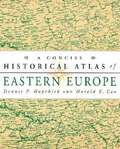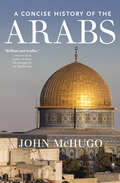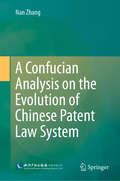- Table View
- List View
A Companion and Guide to the Wars of the Roses
by Peter BramleyThe Wars of the Roses (1455-85) saw the end of Plantagenet rule in England and Wales, and the accession of the Tudor dynasty to the throne. It is sometimes seen as the end of the Middle Ages in England, and the start of the modern era, and it paved the way for the reigns of Henry VIII and Elizabeth I. A surprising number of historic sites from this turbulent period survive: battlefields, castles, churches, monasteries. Peter Bramley's beautifully illustrated field guide and companion to the Wars of the Roses gives full details of both the events and the personalities associated with each of these sites, together with the historical background and the reasons for the struggle between the houses of York and Lancaster. Arranged by region, it covers the whole of England and Wales, and provides invaluable information for anyone visiting or planning to visit any of the sites connected with the conflict, as well as anyone interested in the history of this period in general.
A Companion to Applied Philosophy of AI (Blackwell Companions to Philosophy)
by Martin Hähnel Regina MüllerA comprehensive guide to AI's ethical, epistemological, and legal impacts through applied philosophy Inartificial intelligence (AI) influences nearly every aspect of society. A Companion to Applied Philosophy of AI provides a critical philosophical framework for understanding and addressing its complexities. Edited by Martin Hähnel and Regina Müller, this volume explores AI's practical implications in epistemology, ethics, politics, and law. Moving beyond a narrow ethical perspective, the authors advocate for a multi-faceted approach that synthesizes diverse disciplines and perspectives, offering readers a nuanced and integrative understanding of AI's transformative role. The Companion explores a broad range of topics, from issues of transparency and expertise in AI-driven systems to discussions of ethical theories and their relevance to AI, such as consequentialism, deontology, and virtue ethics. Filling a significant gap in the current academic literature, this groundbreaking volume also addresses AI's broader social, political, and legal dimensions, equipping readers with practical frameworks to navigate this rapidly evolving field. Offering fresh and invaluable insights into the interplay between philosophical thought and technological innovation, A Companion to Applied Philosophy of AI: Features contributions from leading philosophers and interdisciplinary experts Offers a unique applied philosophy perspective on artificial intelligence Covers diverse topics including ethics, epistemology, politics, and law Encourages interdisciplinary dialogue to better understand AI's profound implications for humanity A Companion to Applied Philosophy of AI is ideal for undergraduate and graduate courses in applied philosophy, AI ethics, political theory, and legal philosophy. It is also a vital reference for those working in areas including AI policy, governance, and interdisciplinary research.
A Companion to Hobbes (Blackwell Companions to Philosophy)
by Marcus P. AdamsOffers comprehensive treatment of Thomas Hobbes’s thought, providing readers with different ways of understanding Hobbes as a systematic philosopher As one of the founders of modern political philosophy, Thomas Hobbes is best known for his ideas regarding the nature of legitimate government and the necessity of society submitting to the absolute authority of sovereign power. Yet Hobbes produced a wide range of writings, from translations of texts by Homer and Thucydides, to interpretations of Biblical books, to works devoted to geometry, optics, morality, and religion. Hobbes viewed himself as presenting a unified method for theoretical and practical science—an interconnected system of philosophy that provides many entry points into his thought. A Companion to Hobbes is an expertly curated collection of essays offering close textual engagement with the thought of Thomas Hobbes in his major works while probing his ideas regarding natural philosophy, mathematics, human nature, civil philosophy, religion, and more. The Companion discusses the ways in which scholars have tried to understand the unity and diversity of Hobbes’s philosophical system and examines the reception of the different parts of Hobbes’s philosophy by thinkers such as René Descartes, Margaret Cavendish, David Hume, and Immanuel Kant. Presenting a diversity of fresh perspectives by both emerging and established scholars, this volume: Provides a comprehensive treatment of Hobbes’s thought in his works, including Elements of Law, Elements of Philosophy, and Leviathan Explores the connecting points between Hobbes’ metaphysics, epistemology, mathematics, natural philosophy, morality, and civil philosophy Offers readers strategies for understanding how the parts of Hobbes’s philosophical system fit together Examines Hobbes’s philosophy of mathematics and his attempts to understand geometrical objects and definitions Considers Hobbes’s philosophy in contexts such as the natural state of humans, gender relations, and materialist worldviews Challenges conceptions of Hobbes’s moral theory and his views about the rights of sovereigns Part of the acclaimed Blackwell Companions to Philosophy series, A Companion to Hobbes is an invaluable resource for scholars and advanced students of Early modern thought, particularly those from disciplines such as History of Philosophy, Political Philosophy, Intellectual History, History of Politics, Political Theory, and English.
A Companion to Life Course Studies: The Social and Historical Context of the British Birth Cohort Studies (Routledge Advances in Sociology)
by Michael Wadsworth; John BynnerSince the end of the Second World War, society has been characterised by rapid and extensive political, economic, scientific, and technological change. Opportunities for education, employment, human relations, and good health, have all been greatly affected by those changes, as have all aspects of life. Consequently, each post-war generation has been like no other before or since. Britain, uniquely, has five large-scale life course studies that began at intervals throughout that period. They have shown how lives are shaped by individual characteristics, their past and current experiences and opportunities, and so reflect their times. This book describes those fundamental changes that affected life chances differently in each generation, and how governments struggled to accommodate the changes with new policies for improving and managing the nation's capital in terms of education, family policy, health, human rights, and economics. A Companion to Life Course Studies provides a resource for the interpretation of the findings and design differences in the five studies, and the stimulus for new comparisons of life course between these differing generations that would contribute to policy and to understanding.
A Companion to the Falklands War
by Gregory Fremont-Barnes Julian ThompsonThe Falklands War is a story of occupation, fierce air battles, heavy naval losses and bitter encounters between ground forces amidst an inhospitable terrain and unforgiving climate. With complex political machinations and nationalist sentiment at the centre of the conflict, even today the sovereignty of the islands is hotly contested in political circles. For the first time, renowned military historian Gregory Fremont-Barnes has compiled a definitive A–Z guide to the British involvement in the Falklands conflict, including personalities, weapons, battles, ships, places and much more. This accessible yet comprehensive companion to the Falklands War will be a welcome addition to any enthusiast’s shelves.
A Companion to the Physical Sciences
by David KnightFirst published in 1989, this dictionary of the whole field of the physical sciences is an invaluable guide through the changing terminology and practices of scientific research. Arranged alphabetically, it traces how the meaning of scientific terms have changed over time. It covers a wide range of topics including voyages, observations, magnetism and pendulums, and central subjects such as atom, valency and energy. There are also entries on more abstract terms such as hypothesis, theory, induction, deduction, falsification and paradigm, emphasizing that while science is more than ‘organized common sense’ it is not completely different from other activities. Science’s lack of innocence is also recognized in headings like pollution and weapons. This book will be a useful resource to students interested in the history of science.
A Companion to the Royal Heritage of Britain
by Marc AlexanderMore than a biography of kings and queens, this title is an encyclopaedic work on every aspect of monarchy in Britain from semi-legendary times to the present day. It provides a reference for discovering more about individual monarchs and the huge legacy of myths, traditions and practices which has grown up around the institution of the monarchy.
A Compendium of Collective Nouns: From an Armory of Aardvarks to a Zeal of Zebras
by Woop Studios Jason SacherThis illustrated guide compiles over 2,000 collective nouns and brings them to life in stunningly colorful, graphic artwork from the design dynamos at Woop Studios. Chock-full of treasures of the English language, the diversity of terms collected here covers topics from plants and animals (a parade of elephants, an embarrassment of pandas) to people and things (a pomposity of professors, an exultation of fireworks) and range from the familiar (a pride of lions) to the downright obscure (an ooze of amoebas). Pronunciations, definitions, etymologies, and historical anecdotes make this beautiful book an entertaining read, a standout reference, and a visual treat. Language lovers and art appreciators alike will be captivated by this gem, rich in word and image.
A Compendium of Kisses
by Lana CitronHAVE YOU EVER WONDERED. . . How long the longest kiss lasted? Who discovered the first kiss? The cost of a kiss, and who paid for one with their life? From first kisses to missed kisses, stolen kisses, the chemistry of kisses, around-the-world kisses, silver-screen kisses, Freudian kisses, lipstick kisses and record-breaking kisses, this eclectic collection of facts, figures, quotes and curiosities has everything you've ever wanted to know-and more-about that most deceptive, delightful and indispensable gesture: the kiss.
A Complete Guide To Brass: Instruments And Technique
by Scott Whitener Cathy WhitenerThis authoritative guide provides all the pedagogical, historical, and technical material necessary for the successful instruction of brass. Chapters discuss the historical development of individual brass instruments and focus on technique, including guidance for teachers and a complete method for brass playing. Individual instrument chapters include lists of recommended study material and reference sources.
A Complete Handbook of Literary Forms in the Bible
by Leland RykenA renowned literary scholar explains more than 250 literary forms found throughout Scripture in this alphabetically arranged handbook, offering succinct definitions, helpful illustrations, and key biblical references.
A Complete History of the Lives and Robberies of the Most Notorious Highwaymen, Footpads, Shoplifts and Cheats of Both Sexes: Previously published 1719 and 1926 (Key Writings On Subcultures, 1535-1727 Ser. #Vol. 3)
by Captain Alexander SmithA Complete History of the Highwaymen discloses the most secret and barbarous murders, unparalleled robberies, notorious thefts and unheard of cheats, setting them in a true light and exposing them to public view for the common benefit of mankind. The accounts and confessions are drawn from imprisoned villains who awaited their fate at the gallows. This reprint makes available the 1926 reissue of Captain Smith's fifth edition and includes an introduction by Arthur L. Hayward, which sets the accounts in the appropriate historical context.
A Comprehensive Dictionary of the Middle East
by Dilip HiroIn this up-to-date, painstakingly researched dictionary, author Dilip Hiro brings one of the most tumultuous regions of the world to our fingertips. It is easy-to-read, simple to use, authoritative, and comprehensive. If offers a wide range of alphabetically arranged information on topics ranging from current affairs, history and politics to religions, literature and tourist destinations.Topics covered include: Arab Spring, Arab-Israeli Wars, Biographies, Christianity and Christian Sects, Civil Wars, Country Profiles, Ethnic Groups, Government, Gulf Wars, Historical Places, History, Hostages, International Agreements and Treaties, Islam and Islamic Sects, Judaism and Jewish Sects, Languages, Literary Personalities, Military and Military Leaders, Nonconventional and Nuclear Weapons, Oil and Gas, Peace Process, Politics, Regional Conflicts, Religion, Terrorism, Tourist Destinations, United Nations, and much more.This is a must-have reference for anyone genuinely interested in understanding more about the history and current events of the Middle East.
A Concise Dictionary of Architectural Terms
by John Henry ParkerJohn Henry Parker's remarkably timeless dictionary of architecture, first published in 1846, became such a success that he continued to revise it for several years. A profusely illustrated manual that is valuable as a reference or as a portable guide on visits to historical buildings, this authoritative glossary of nearly 500 words used in Greek, Roman, Italian, and Gothic architecture remains highly instructive and informative.Accurate engravings complement many of the author's incisive descriptions -- from a buttress in Glastonbury Abbey to zig-zag mouldings in a Norman doorway. Extended entries cover arches, windows, tombs, and other architectural elements; while shorter notes define less commonly used terms such as cavetto, dado, and embrasure.An indispensable reference for architects and students of architecture, the text includes a topographical index to the illustrations, identifying the many British cathedrals, castles, and parish churches used as examples.
A Concise Dictionary of Comics
by Nancy PedriWritten in straightforward, jargon-free language, A Concise Dictionary of Comics guides students, researchers, readers, and educators of all ages and at all levels of comics expertise. It provides them with a dictionary that doubles as a compendium of comics scholarship. A Concise Dictionary of Comics provides clear and informative definitions for each term. It includes twenty-five witty illustrations and pairs most defined terms with references to books, articles, book chapters, and other relevant critical sources. All references are dated and listed in an extensive, up-to-date bibliography of comics scholarship. Each term is also categorized according to type in an index of thematic groupings. This organization serves as a pedagogical aid for teachers and students learning about a specific facet of comics studies and as a research tool for scholars who are unfamiliar with a particular term but know what category it falls into. These features make A Concise Dictionary of Comics especially useful for critics, students, teachers, and researchers, and a vital reference to anyone else who wants to learn more about comics.
A Concise Dictionary of Correct English
by B. PhythianThis easy A-to-Z reference guide offers essential information on English grammar as well as practical advice on avoiding common mistakes. A thorough understanding of English grammar is essential for anyone who wishes to communicate clearly and confidently. A Concise Dictionary of Correct English offers readers a detailed overview of English usage, provided in a quick-reference alphabetical format. From the rules of &“Abbreviations&” and &“Accents&” to the proper deployment of &“Would&” versus &“Should&”, this thorough and accessible volume is an ideal resource for improving one&’s grasp of English.
A Concise Dictionary of First Names
by Patricia Hanks Flavia HodgesHere is the ultimate first name handbook, a delightfully informative, comprehensive survey of over 4,500 European and American names (with two appendices covering the most common Arabic and Indian names). The real charm and value of this reference lies in the wealth of fascinating additional information the authors provide. Under the entry for "Audrey," for example, we learn of the sixth century saint of that name--who died from a neck tumor, divine punishment for her youthful delight in fine necklaces--from whom the word "tawdry" derives: it referred originally to the cheap jewelry sold at fairs in her honor (St. Audrey eventually being compressed into "tawdry"). The authors reveal that the name "Colleen," a very popular name among Irish Americans, is in fact never given as a first name in Ireland; that the name "Wendy" didn't exist until J.M. Barrie invented it for Peter Pan; that "Algernon" originally meant "moustached" and was a nickname among the predominantly clean-shaven Norman French; and that the "th" in our spelling of "Anthony" comes from an erroneous confusion with the Greek word for flower, anthos. Perhaps more important, this dictionary is an authoritative reference. Indeed, no other handbook provides a fraction of the information found here. Typical entries provide the linguistic and ethnic root of a name. "Jennifer," for instance, is a Cornish form of "Guinevere," which in turn is the French version of a Welsh name combining gwen, white, fair, smooth, and hwyfar, smooth, soft. Most entries also include the non-English form or cognate of a name. The name "Geronimo" is an Italian cognate of Jerome, whose Dutch cognate, "Jeroen," the authors point out, was the most popular male name in Holland in 1981. In addition, entries include diminutives and pet forms. A companion to the authors' A Dictionary of Surnames, this informative reference offers a goldmine of curious facts to delight browsers of every age as well as a wealth of inspiration for prospective parents. It is an ideal baby shower gift.
A Concise Dictionary of Markets and Investing
by Jim Cramer TheStreet"I learned a ton from reading this little book. You can too." Jim Cramer This is a dictionary of key market and investing terms to help individuals and organizations grow their wealth. A comprehensive financial dictionary with more than 180 terms in such fields as mutual funds, banking, stocks, bonds, tax laws, and transactions in the various financial markets presented alphabetically with descriptions. Everyone needs a dictionary of market and investing terms in today's ever changing and complex marketplace. This is the place to begin. Jim Cramer's Introduction sets the Dictionary in context. Purposely written and designed for the digital marketplace where precision, speed and transparency are fundamental, this is destined to become an eBook investment classic. About The Street Since its inception in 1996, The Street has distinguished itself from other financial media companies with its journalistic excellence, unbiased approach and interactive multimedia coverage of the financial markets, economy, industry trends, investment and financial planning. The Street's mission is to provide the most actionable ideas from the world of investing, finance and business in order to break down information barriers, level the playing field and help all individuals and organizations grow their wealth. With an unmatched suite of digital services, The Street offers all of the tools and insight needed to make the best decisions about earning, investing, saving and spending money. Today, The Street is more than 160 journalists delivering actionable ideas every day. About Jim Cramer Jim Cramer runs the charitable trust portfolio Action Alerts PLUS and writes daily market commentary for RealMoney, a premium service from The Street. He also participates in video segments on The Street TV and serves as host of CNBC's "Mad Money" television program. Cramer graduated magna cum laude from Harvard College, where he was president of The Harvard Crimson. He received his law degree from Harvard in 1984. Instead of practicing law, however, he joined Goldman Sachs, leaving to start his own hedge fund. While he worked at his fund, Cramer played a key role in launching Smart Money magazine for Dow Jones and then, in 1996, founded The Street, the preeminent financial website on investing. In 2000, Cramer retired from active money management to embrace media full time, including radio and television. About the Editors This dictionary was begun in 1999 as project to convey critically important market and trading terms to a non-Wall Street audience of individual investors and active traders. Editors refreshed and added to the material through the years, reflecting changes in markets, technology, and the growing sophistication of the investing public.
A Concise Dictionary of the Avant-Gardes: Concise Edition
by Richard KostelanetzFor a concise edition of his legendary arts dictionary of information and opinion, the distinguished critic and arts historian Richard Kostelanetz selects entries from the 2018 third edition. Typically he provides intelligence unavailable anywhere else, no less in print than online, about a wealth of subjects and individuals. Focused upon what is truly innovative and excellent, Kostelanetz also ranges widely with insight and surprise, including appreciations of artistic athletes such as Muhammad Ali and the Harlem Globetrotters and such collective creations as Las Vegas and his native New York City. Continuing the traditions of cheeky high-style Dictionarysts, honoring Ambrose Bierce and Samuel Johnson (both with individual entries), Kostelanetz offers a "reference book" to be enjoyed, not only in bits and chunks but continuously as one of the ten books someone would take if he or she planned to be stranded on a desert isle.
A Concise Encyclopedia (2nd edition)
by Jonathan Law Alan IsaacsLively, accessible, and up-to-date, the Concise Encyclopedia is an invaluable quick-reference work. Its compact size and clear concise style make it easy to find information quickly and painlessly on virtually any topic you are curious about. The more than 12,000 entries here cover an extraordinary array of fields, ranging from science and technology, to the arts, politics, sports, geography, folklore and mythology, architecture, literature, design, and philosophy. Whether you are curious about Atoms or Anemones, Hinduism or Hockey, Marxism or Medusa, Stick Insects or Stockholm--or almost any other subject imaginable--you will find here a wealth of accurate, compact entries. The Encyclopedia also includes brief biographies of a host of important individuals, from Igor Stravinsky and Robert Louis Stevenson to Patrick Henry and Herod the Great, with ample coverage of internationally famous world figures alive today, from George W. Bush and Tony Blair to contemporary actors, artists, and sports stars. The Encyclopedia also features maps of the world. Fully illustrated with line drawings and diagrams, the perfect desk reference for family, student, or professional use, Concise Encyclopedia offers a wealth of essential information in a portable, affordable package.
A Concise Handbook of Business Research: Special Emphasis on Data Analysis Using MS-Excel and R
by Vishnu Nath Ashish Arya Pankaj MadanThis book deals with the basics of Research Methodology (RM) for Business Research and statistical analysis for dealing with data using two software: R (a free statistical analysis environment) and MS-Excel. Apart from the basic concepts of Research Methodology, the book contains an additional chapter on improving academic writing. It contains important details on plagiarism, citation and referencing in MS-Word, and improving project/dissertation writing using free online software. Print edition not for sale in South Asia (India, Sri Lanka, Nepal, Bangladesh, Pakistan or Bhutan)
A Concise Hebrew and Aramaic Lexicon of the Old Testament
by William L. HolladayBased on the First, Second, and Third Editions of the Koehler-Baumgartner Lexicon in Veteris Testamenti Libros, this abridgment--which eliminates bibliographical references and technical information intended for specialists and judiciously trims biblical citations--provides everything the student needs to translate an Old Testament passage.
A Concise Historical Atlas of Eastern Europe
by Dennis P. Hupchick Harold E. CoxThis atlas is concerned with the part of Europe extending from the Balkan Peninsula in the south to Poland and Lithuania in the north.
A Concise History of the Arabs
by John McHugoThis &“brilliant and erudite&” history by the award-winning Arabist provides vital context for understanding the contemporary Middle East (Patrick Seale, author of Asad: The Struggle for the Middle East). From Algeria and Libya to Egypt, Syria, and Saudi Arabia, the Arab world commands Western headlines. Nowhere else does the unfolding of events have such significant consequences for America. And yet its complex politics and cultures elude the grasp of most Western readers and commentators. A Concise History of the Arabs provides an essential road map to understanding the Arab world today, and in the years ahead. Noted Arab scholar John McHugo guides readers through the political, social, and intellectual history of the Arabs from the Roman Empire to the present day. Taking readers beyond the headlines, McHugo vividly describes the crucial turning points in Arab history—from the Prophet Muhammad&’s mission and the expansion of Islam to the region&’s interaction with Western ideas and the rise of Islamism. This lucidly told history reveals how the Arab world came into its present form, why major shifts like the Arab Spring were inevitable, and what may lie ahead for the region. A Choice Outstanding Academic Title, this accessible history is &“the product of wide reading, hard thinking and years of direct experience of the Middle East . . . There are lively and informative insights on almost every page&” (Patrick Seale, author of Asad: The Struggle for the Middle East).
A Confucian Analysis on the Evolution of Chinese Patent Law System
by Nan ZhangThis book comprehensively discusses the main features of the Chinese patent law system, which not only legally ‘transplants’ international treaties into the Chinese context, but also maintains China’s legal culture and promotes domestic economic growth. This is the basis for encouraging creativity and improving patent law protection in China. The book approaches the evolution of the Chinese patent system through the ancient Chinese philosopher Confucius’s classic principle, offering readers a fresh new way to understand and analyze Chinese patent law reforms, while also outlining how Confucian insights could be used to improve the enforcement of patent law and overall intellectual property protection awareness in China. It examines ancient Chinese innovation history, explores intellectual property from a Confucian perspective, and discusses the roots of Chinese patent law, as well as the past three amendments and the trends in the ongoing fourth amendment. In addition to helping readers grasp the mentality behind the Chinese approach to patent law and patent protection, the book provides an alternative research methodology and philosophical approach by demonstrating Confucian analysis, which provides a more dynamic way to justify intellectual property in the academic world. Lastly, it suggests future strategies for local industries in the legal, cultural and sociological sectors in China, which provide benefits for domestic and overseas patent holders alike. The book offers a valuable asset for graduate students and researchers on China and intellectual property law, as well as general readers interested in Asian culture and the philosophy of law.
